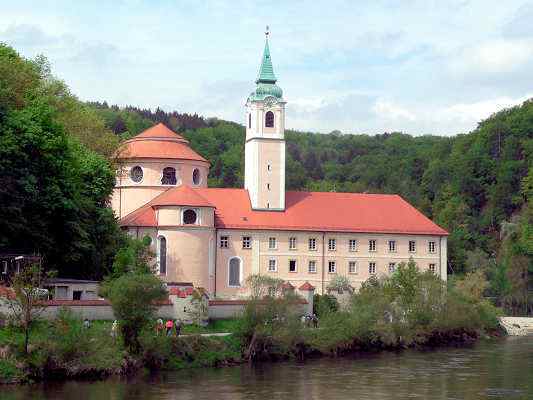
Weltenburg Abbey
at Kelheim in the national park Altmuehl valley
The spur-shaped summit near the bend of the Danube has attracted people for thousands of years. For the Celts the summit was so important that they fortified the place. This fortification, dating back to the bronze age, is said to have been called "Artobriga" - high castle; at least Claudius Ptolemaios, the famous ancient geographer, said so.
On the ruins of the Celtic fortress, the Romans built a small frontier castle and a temple dedicated to Minerva. St. Rupert, patron saint and founder of the archdiocese of Salzburg, is said to have transformed this temple into a church of St. Mary. But that is not provable.
Another legend tells that Eustachius, a monk from Luxeuil, founded a monastery on the ruins of the abandoned Roman castle, and this would be the oldest monastery of Bavaria.
In an 11th century chronicle, written in Weltenburg, the famous Bavarian Duke Tassilo III. (742-794) ![]() is mentioned as founder of the monastery. The duke presumably removed the monastery from the summit of the hill to the bank of the river and called Benedictines to settle there.
is mentioned as founder of the monastery. The duke presumably removed the monastery from the summit of the hill to the bank of the river and called Benedictines to settle there.
In the 12th century, Weltenburg was for several years a convent of St. Augustine prebendaries, but was later given back to the Benedictines and was made an abbey.
The abbey had considerable landed property at its disposal, but as it was far away from major cities and traffic routes it could not grow to be one of the high ranking abbeys of the Holy Roman Empire.
Weltenburg had to suffer a lot of damage and destruction, especially in the Thirty Years´ War. The height of its prosperity th was in the beginning of the 18th century, when Abbot Maurus Bachl had the old church be pulled down and ordered to construct a new church and new convent buildings.
On June 29th, 1716, they laid the foundation-stone of the new conventual church. Abbot Maurus, who had before been the prior of Ensdorf monastery, knew two young men who had done an excellent job in Ensdorf. And so he engaged the brothers, Cosmas Darnian Asam as architect and Egid Quinn Asam as painter and stucco-worker. They were inspired by the baroque Italian architect Lorenzo Bernini.
Brickwork was finished after two years, the frescoed ceiling and high altar three years later. The interior decorations and fittings were not completed before 1735. An astounding ensemble of baroque architecture and fresco painting adorned the land.
But in 1803 the catastrophe befell the abbey. In connection with the Napoleonic Wars, the abbey - and most other abbeys in Bavaria - was secularized and bereft of its money and landed property. More than 1100 years of monastic life ended abruptly. For about 40 years the abbey was empty and in serious danger of suffering irreparable damages.
In 1842, King Ludwig I of Bavaria, arranged the new establishment of the abbey.
back to the Homepage of the town Kelheim ![]()
Zuletzt aktualisiert am 10.02.2017